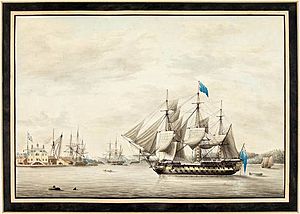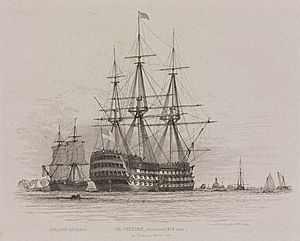Thomas Slade facts for kids
Sir Thomas Slade (born 1703 or 1704 – died 1771) was a brilliant English ship designer. He is most famous for creating the plans for HMS Victory. This famous warship was the flagship of Lord Nelson during the important Battle of Trafalgar in 1805.
Contents
Early Life and Start in Shipbuilding
Thomas Slade was the son of Arthur Slade and Hannah Moore. His uncle, Benjamin Slade, was a Master Shipwright. This was a very important job in the Royal Dockyards. A Master Shipwright was in charge of building and fixing all the ships at a dockyard. Like many top ship designers, Thomas Slade started his career working in these Royal Dockyards.
A Career Building Ships
Thomas Slade worked his way up in the Royal Dockyards. In 1744, he became the Deputy Master Shipwright at Woolwich Dockyard. This meant he was second in command.
In 1750, he took over from his uncle as the Master Shipwright at Plymouth. Over the next few years, he moved to different important dockyards. These included Woolwich, Chatham Dockyard, and Deptford Dockyard.
In August 1755, he got a very important job: Surveyor of the Navy. This meant he was the chief designer and overseer for all ships built for the Royal Navy. He shared this role with another person for a while, but he was always the main leader. He kept this job until he passed away in 1771. For his great work, he was made a knight in 1768, becoming Sir Thomas Slade.
Amazing Ship Designs
Sir Thomas Slade was considered the greatest British naval architect of his time. He designed ships that were perfect for Britain's needs. Many people agreed that no one else matched his skill.
During his time as Surveyor, Slade made some big changes to ship design. He created a "standard design" for the Royal Navy's 74-gun ships and frigates. These 74-gun ships were powerful warships. They were designed to be as good as, or better than, the French 74-gun ships. At least 46 ships were built using his 74-gun designs.
He also designed HMS Asia. This was the first true 64-gun ship. Because of its success, the Royal Navy stopped ordering 60-gun ships. Instead, they ordered more 64-gun ships based on Slade's ideas.
Slade also designed smaller ships. One example is the 10-gun cutter, HMS Sherborne. This ship was used by the Board of Customs.
His most famous ship was, without a doubt, the HMS Victory. This ship became the most successful "first-rate" ship of the line ever built. In 1758, the Navy ordered 12 new ships, including one with 100 guns. The next year, they chose the name Victory for this ship. It's interesting to note that in 1758, Lord Nelson was born. He would later die on the decks of Victory at the Battle of Trafalgar.
Sir Thomas Slade's designs played a huge role in the Battle of Trafalgar. Out of the 33 ships Nelson had, eight were built using Slade's plans. These included the Victory itself. Two more of his ships had been captured by the French and fought on the French side! This means that about a quarter of Nelson's ships at Trafalgar were designed by Slade.
Death and Lasting Impact
Sir Thomas Slade passed away on February 23, 1771, in Bath. He is buried in St Clement's churchyard in Ipswich.
His work left a lasting mark. For example, Slade Point in Queensland, Australia, is named after him. One of his apprentices, John Henslow, also became a chief ship designer for the Navy. John Henslow was even the grandfather of John Henslow, who was a mentor to the famous scientist Charles Darwin.




